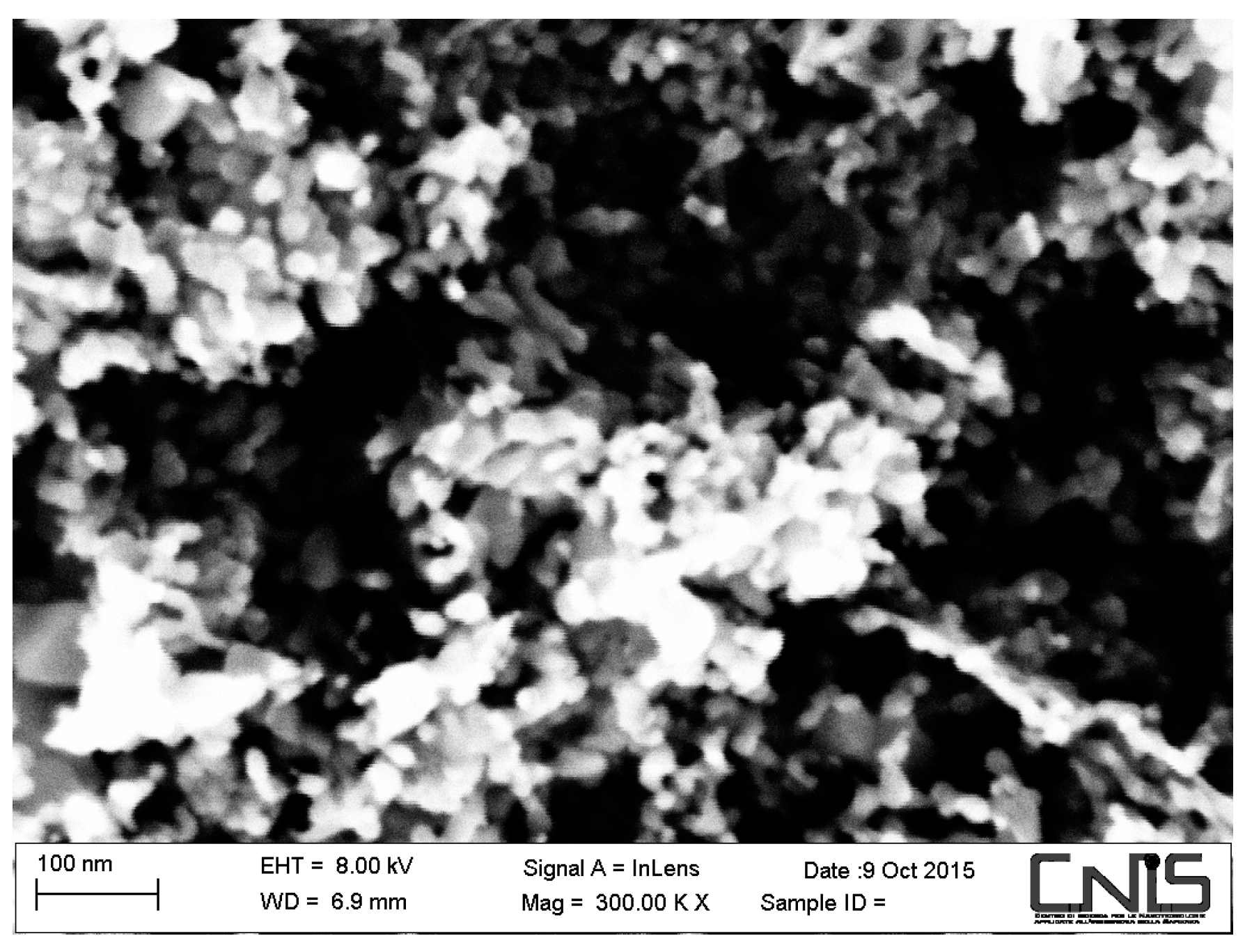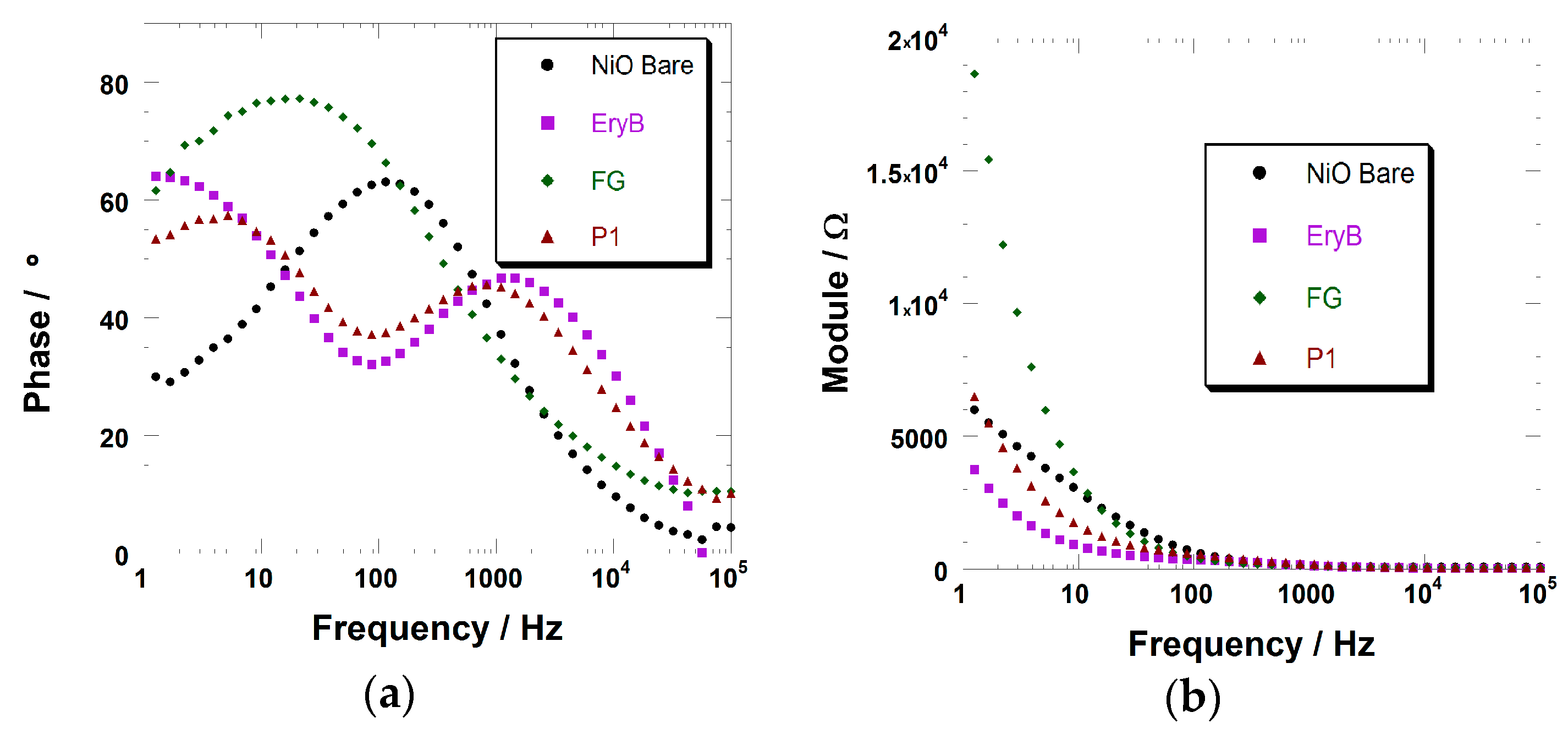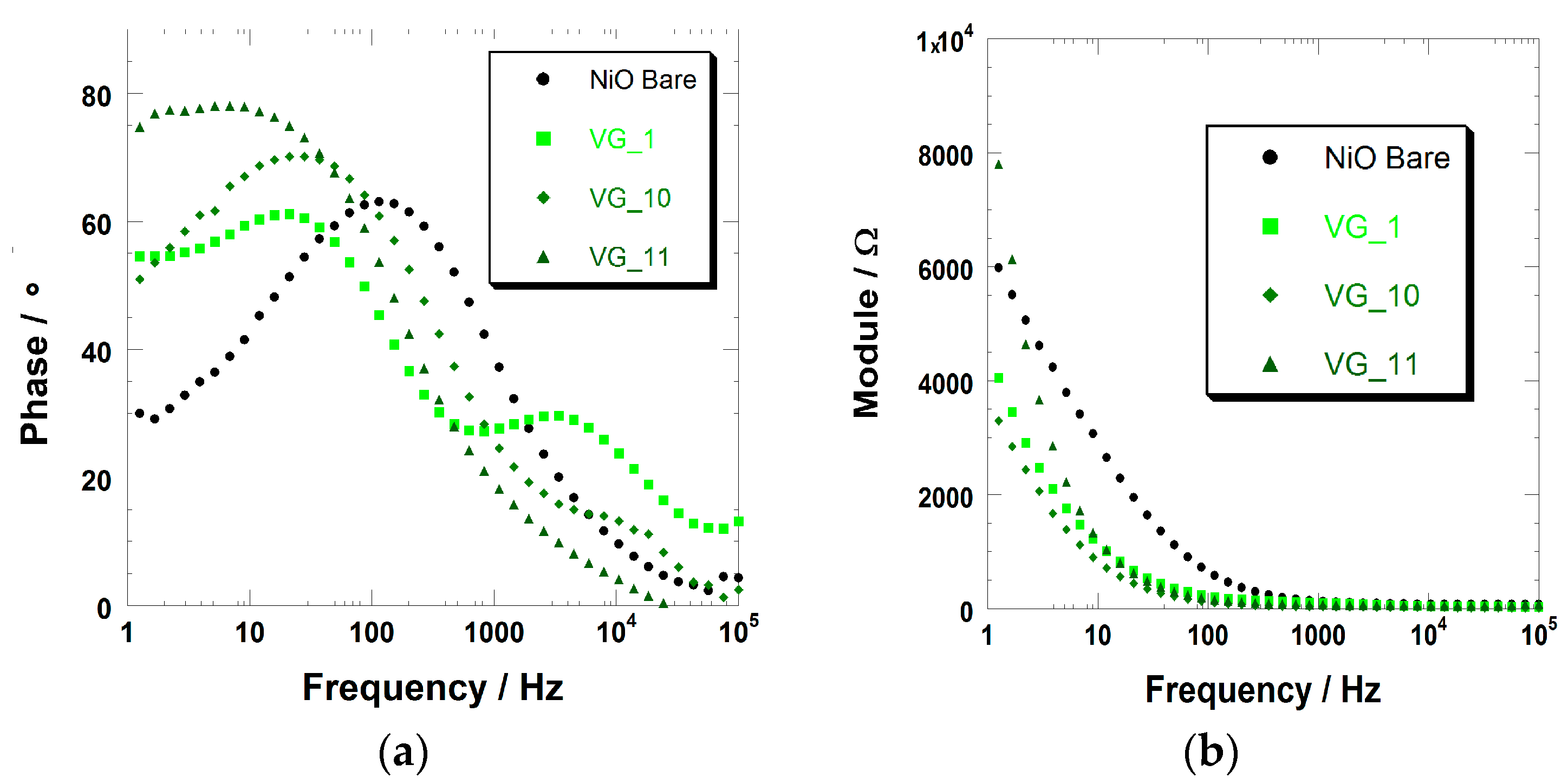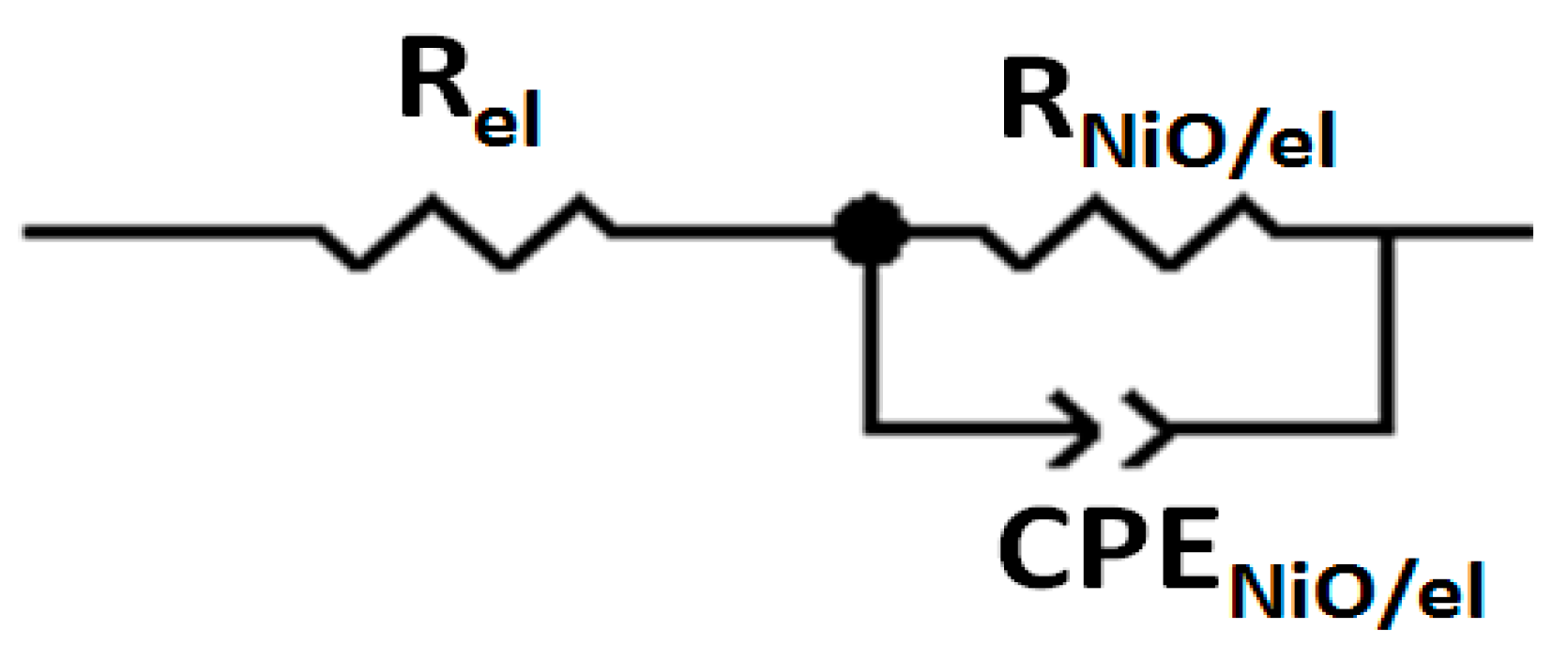Effect of Sensitization on the Electrochemical Properties of Nanostructured NiO
Abstract
:1. Introduction
2. Materials and Methods
3. Results and Discussion
3.1. Analysis of the Voltammetric Data
3.2. Analysis of the Impedance Spectra
4. Conclusions
Supplementary Materials
Author Contributions
Funding
Conflicts of Interest
References
- Passerini, S.; Scrosati, B. Characterization of Nonstoichiometric Nickel Oxide Thin-Film Electrodes. J. Electrochem. Soc. 1994, 141, 889–895. [Google Scholar] [CrossRef]
- Wei, L.; Jiang, L.; Yuan, S.; Ren, X.; Zhao, Y.; Wang, Z.; Zhang, M.; Shi, L.; Li, D. Valence Band Edge Shifts and Charge-transfer Dynamics in Li-Doped NiO Based p-type DSSCs. Electrochim. Acta 2016, 188, 309–316. [Google Scholar] [CrossRef]
- He, J.; Lindström, H.; Hagfeldt, A.; Lindquist, S.-E. Dye-Sensitized Nanostructured p-Type Nickel Oxide Film as a Photocathode for a Solar Cell. J. Phys. Chem. B 1999, 103, 8940–8943. [Google Scholar] [CrossRef]
- Sahara, G.; Abe, R.; Higashi, M.; Morikawa, T.; Maeda, K.; Ueda, Y.; Ishitani, O. Photoelectrochemical CO2 reduction using a Ru(II)-Re(I) multinuclear metal complex on a p-type semiconducting NiO electrode. Chem. Commun. 2015, 51, 10722–10725. [Google Scholar] [CrossRef] [PubMed]
- Gross, M.A.; Creissen, C.E.; Orchard, K.L.; Reisner, E. Photoelectrochemical hydrogen production in water using a layer-by-layer assembly of a Ru dye and Ni catalyst on NiO. Chem. Sci. 2016, 7, 5537–5546. [Google Scholar] [CrossRef] [Green Version]
- Dini, D. Nanostructured Metal Oxide Thin Films as Photoactive Cathodes of p-Type Dye-Sensitised Solar Cells. Phys. Chem. Commun. 2016, 3, 14–51. [Google Scholar]
- Shan, B.; Sherman, B.D.; Klug, C.M.; Nayak, A.; Marquard, S.L.; Liu, Q.; Bullock, R.M.; Meyer, T.J. Modulating Hole Transport in Multilayered Photocathodes with Derivatized p-Type Nickel Oxide and Molecular Assemblies for Solar-Driven Water Splitting. J. Phys. Chem. Lett. 2017, 4374–4379. [Google Scholar] [CrossRef] [PubMed]
- Li, L.; Dai, H.; Luo, D.; Wang, S.; Sun, X. Nickel Oxide Nanosheets for Enhanced Photoelectrochemical Water Splitting by Hematite (α-Fe2O3) Nanowire Arrays. Energy Technol. 2016, 639798, 758–763. [Google Scholar] [CrossRef]
- Yao, K.; Li, F.; He, Q.; Wang, X.; Jiang, Y.; Huang, H.; Jen, A.K.Y. A copper-doped nickel oxide bilayer for enhancing efficiency and stability of hysteresis-free inverted mesoporous perovskite solar cells. Nano Energy 2017, 40, 155–162. [Google Scholar] [CrossRef]
- Mihelčič, M.; Šurca Vuk, A.; Jerman, I.; Orel, B.; Švegl, F.; Moulki, H.; Faure, C.; Campet, G.; Rougier, A. Comparison of electrochromic properties of Ni1−xO in lithium and lithium-free aprotic electrolytes: From Ni1−xO pigment coatings to flexible electrochromic devices. Sol. Energy Mater. Sol. Cells 2014, 120, 116–130. [Google Scholar] [CrossRef]
- Da Rocha, M.; Rougier, A. Electrochromism of non-stoichiometric NiO thin film: As single layer and in full device. Appl. Phys. A Mater. Sci. Process. 2016, 122. [Google Scholar] [CrossRef]
- Wen, R.T.; Granqvist, C.G.; Niklasson, G.A. Anodic electrochromism for energy-efficient windows: Cation/anion-based surface processes and effects of crystal facets in nickel oxide thin films. Adv. Funct. Mater. 2015, 25, 3359–3370. [Google Scholar] [CrossRef]
- Zhao, C.C.; Chen, C.; Du, F.L.; Wang, J.M. Template synthesis of NiO ultrathin nanosheets using polystyrene nanospheres and their electrochromic properties. RSC Adv. 2015, 5, 38533–38537. [Google Scholar] [CrossRef]
- Estrada, W.; Andersson, A.M.; Granqvist, C.G.; Gorenstein, A.; Decker, F. Infrared reflectance spectroscopy of electrochromic NiOxHy films made by reactive DC sputtering. J. Mater. Res. 1991, 6, 1715–1719. [Google Scholar] [CrossRef]
- Choi, S.H.; Kang, Y.C. Ultrafast synthesis of yolk-shell and cubic NiO nanopowders and application in lithium ion batteries. ACS Appl. Mater. Interfaces 2014, 6, 2312–2316. [Google Scholar] [CrossRef] [PubMed]
- Gu, L.; Xie, W.; Bai, S.; Liu, B.; Xue, S.; Li, Q.; He, D. Facile fabrication of binder-free NiO electrodes with high rate capacity for lithium-ion batteries. Appl. Surf. Sci. 2016, 368, 298–302. [Google Scholar] [CrossRef]
- Yue, G.H.; Zhao, Y.C.; Wang, C.G.; Zhang, X.X.; Zhang, X.Q.; Xie, Q.S. Flower-like nickel oxide nanocomposites anode materials for excellent performance lithium-ion batteries. Electrochim. Acta 2015, 152, 315–322. [Google Scholar] [CrossRef]
- Wang, C.; Wang, T.; Wang, B.; Zhou, X.; Cheng, X.; Sun, P.; Zheng, J.; Lu, G. Design of α-Fe2O3 nanorods functionalized tubular NiO nanostructure for discriminating toluene molecules. Sci. Rep. 2016, 6, 26432. [Google Scholar] [CrossRef] [PubMed]
- Wang, C.; Cui, X.; Liu, J.; Zhou, X.; Cheng, X.; Sun, P.; Hu, X.; Li, X.; Zheng, J.; Lu, G. Design of Superior Ethanol Gas Sensor Based on Al-Doped NiO Nanorod-Flowers. ACS Sens. 2016, 1, 131–136. [Google Scholar] [CrossRef]
- Bai, G.; Dai, H.; Deng, J.; Liu, Y.; Ji, K. Porous NiO nanoflowers and nanourchins: Highly active catalysts for toluene combustion. Catal. Commun. 2012, 27, 148–153. [Google Scholar] [CrossRef]
- Yang, J.; Lai, Y.; Chen, J.S. Effect of heat treatment on the properties of non-stoichiometric p-type nickel oxide films deposited by reactive sputtering. Thin Solid Films 2005, 488, 242–246. [Google Scholar] [CrossRef]
- Cavallo, C.; Di Pascasio, F.; Latini, A.; Bonomo, M.; Dini, D. Nanostructured Semiconductor Materials for Dye-Sensitized Solar Cells. J. Nanomater. 2017, 2017, 5323164. [Google Scholar] [CrossRef]
- D’Amario, L.; Jiang, R.; Cappel, U.B.; Gibson, E.A.; Boschloo, G.; Rensmo, H.; Sun, L.; Hammarström, L.; Tian, H. Chemical and Physical Reduction of High Valence Ni States in Mesoporous NiO Film for Solar Cell Application. ACS Appl. Mater. Interfaces 2017, 9, 33470–33477. [Google Scholar] [CrossRef] [PubMed]
- Boschloo, G.; Hagfeldt, A. Characteristics of the iodide/triiodide redox mediator in dye-sensitized solar cells. Acc. Chem. Res. 2009, 42, 1819–1826. [Google Scholar] [CrossRef] [PubMed]
- Awais, M.; Dini, D.; Don MacElroy, J.M.; Halpin, Y.; Vos, J.G.; Dowling, D.P. Electrochemical characterization of NiO electrodes deposited via a scalable powder microblasting technique. J. Electroanal. Chem. 2013, 689, 185–192. [Google Scholar] [CrossRef] [Green Version]
- Marrani, A.G.; Novelli, V.; Sheehan, S.; Dowling, D.P.; Dini, D. Probing the redox states at the surface of electroactive nanoporous nio thin films. ACS Appl. Mater. Interfaces 2014, 6, 143–152. [Google Scholar] [CrossRef] [PubMed]
- Bonomo, M.; Marrani, A.G.; Novelli, V.; Awais, M.; Dowling, D.P.; Vos, J.G.; Dini, D. Surface properties of nanostructured NiO undergoing electrochemical oxidation in 3-methoxy-propionitrile. Appl. Surf. Sci. 2017, 403, 441–447. [Google Scholar] [CrossRef]
- Nakaoka, K.; Ueyama, J.; Ogura, K. Semiconductor and electrochromic properties of electrochemically deposited nickel oxide films. J. Electroanal. Chem. 2004, 571, 93–99. [Google Scholar] [CrossRef]
- Surca, A.; Orel, B.; Pihlar, B.; Bukovec, P. Optical, spectroelectrochemical and structural properties of sol-gel derived Ni-oxide electrochromic film. J. Electroanal. Chem. 1996, 408, 83–100. [Google Scholar] [CrossRef]
- Moulki, H.; Faure, C.; Mihelčič, M.; Šurca Vuk, A.; Švegl, F.; Orel, B.; Campet, G.; Alfredsson, M.; Chadwick, A.V.; Gianolio, D.; et al. Electrochromic performances of nonstoichiometric NiO thin films. Thin Solid Films 2014, 553, 63–66. [Google Scholar] [CrossRef]
- Xia, X.H.; Tu, J.P.; Zhang, J.; Wang, X.L.; Zhang, W.K.; Huang, H. Electrochromic properties of porous NiO thin films prepared by a chemical bath deposition. Sol. Energy Mater. Sol. Cells 2008, 92, 628–633. [Google Scholar] [CrossRef]
- Balaev, D.A.; Dubrovskiy, A.A.; Krasikov, A.A.; Popkov, S.I.; Balaev, A.D.; Shaikhutdinov, K.A.; Kirillov, V.L.; Mart’yanov, O.N. Magnetic properties of NiO nano particles: Contributions of the antiferromagnetic and ferromagnetic subsystems in different magnetic field ranges up to 250 kOe. Phys. Solid State 2017, 59, 1547–1552. [Google Scholar] [CrossRef]
- Zhang, X.K.; Yuan, J.J.; Xie, Y.M.; Yu, Y.; Yu, H.J.; Zhu, X.R.; Kuang, F.G.; Shen, H. Magnetic nature of surface and exchange bias effect in NiO nanosheets. Appl. Phys. Lett. 2016, 109. [Google Scholar] [CrossRef]
- Cai, G.; Wang, X.; Cui, M.; Darmawan, P.; Wang, J.; Eh, A.L.S.; Lee, P.S. Electrochromo-supercapacitor based on direct growth of NiO nanoparticles. Nano Energy 2015, 12, 258–267. [Google Scholar] [CrossRef]
- Liu, Q.; Wei, L.; Yuan, S.; Ren, X.; Zhao, Y.; Wang, Z.; Zhang, M.; Shi, L.; Li, D.; Li, A. Influence of interface properties on charge density, band edge shifts and kinetics of the photoelectrochemical process in p-type NiO photocathodes. RSC Adv. 2015, 5, 71778–71784. [Google Scholar] [CrossRef]
- Bonomo, M.; Naponiello, G.; Venditti, I.; Zardetto, V.; Carlo, A.D.; Dini, D. Electrochemical and Photoelectrochemical Properties of Screen-Printed Nickel Oxide Thin Films Obtained from Precursor Pastes with Different Compositions. J. Electrochem. Soc. 2017, 164, H137–H147. [Google Scholar] [CrossRef]
- Piccinin, S.; Rocca, D.; Pastore, M. Role of Solvent in the Energy Level Alignment of Dye-Sensitized NiO Interfaces. J. Phys. Chem. C 2017, 121, 22286–22294. [Google Scholar] [CrossRef]
- Pham, T.T.T.; Saha, S.K.; Provost, D.; Farré, Y.; Raissi, M.; Pellegrin, Y.; Blart, E.; Vedraine, S.; Ratier, B.; Aldakov, D.; et al. Toward Efficient Solid-State p-Type Dye-Sensitized Solar Cells: The Dye Matters. J. Phys. Chem. C 2017, 121, 129–139. [Google Scholar] [CrossRef]
- Ameline, D.; Diring, S.; Farre, Y.; Pellegrin, Y.; Naponiello, G.; Blart, E.; Charrier, B.; Dini, D.; Jacquemin, D.; Odobel, F. Isoindigo derivatives for application in p-type dye sensitized solar cells. RSC Adv. 2015, 5, 85530–85539. [Google Scholar] [CrossRef]
- Nattestad, A.; Mozer, A.J.; Fischer, M.K.R.; Cheng, Y.-B.; Mishra, A.; Bäuerle, P.; Bach, U. Highly efficient photocathodes for dye-sensitized tandem solar cells. Nat. Mater. 2009, 9, 31–35. [Google Scholar] [CrossRef] [PubMed]
- Odobel, F.; Pellegrin, Y. Recent advances in the sensitization of wide-band-gap nanostructured p-type semiconductors. Photovoltaic and photocatalytic applications. J. Phys. Chem. Lett. 2013, 4, 2551–2564. [Google Scholar] [CrossRef]
- Wood, C.J.; Cheng, M.; Clark, C.A.; Horvath, R.; Clark, I.P.; Hamilton, M.L.; Towrie, M.; George, M.W.; Sun, L.; Yang, X.; et al. Red-absorbing cationic acceptor dyes for photocathodes in tandem solar cells. J. Phys. Chem. C 2014. [Google Scholar] [CrossRef]
- Nikolaou, V.; Charisiadis, A.; Charalambidis, G. Recent advances and insights in dye-sensitized NiO photocathodes for photovoltaic devices. J. Mater. Chem. A Mater. Energy Sustain. 2017, 121, 21077–21113. [Google Scholar] [CrossRef]
- Bonomo, M.; Saccone, D.; Magistris, C.; Di Carlo, A.; Barolo, C.; Dini, D. Effect of alkyl chain length on the sensitizing action of substituted non symmetric squaraines for p-type dye-sensitized solar cells. ChemElectroChem 2017, 4, 2385–2397. [Google Scholar] [CrossRef]
- Farré, Y.; Raissi, M.; Fihey, A.; Pellegrin, Y.; Blart, E.; Jacquemin, D.; Odobel, F. A Blue Diketopyrrolopyrrole Sensitizer with High Efficiency in Nickel-Oxide-based Dye-Sensitized Solar Cells. ChemSusChem 2017, 10, 2618–2625. [Google Scholar] [CrossRef] [PubMed]
- Naik, P.; Planchat, A.; Pellegrin, Y.; Odobel, F.; Vasudeva Adhikari, A. Exploring the application of new carbazole based dyes as effective p-type photosensitizers in dye-sensitized solar cells. Sol. Energy 2017, 157, 1064–1073. [Google Scholar] [CrossRef]
- Farré, Y.; Raissi, M.; Fihey, A.; Pellegrin, Y.; Blart, E.; Jacquemin, D.; Odobel, F. Synthesis and properties of new benzothiadiazole-based push-pull dyes for p-type dye sensitized solar cells. Dyes Pigments 2017, 148, 154–166. [Google Scholar] [CrossRef]
- Sinopoli, A.; Wood, C.J.; Gibson, E.A.; Elliott, P.I.P. New cyclometalated iridium(III) dye chromophore complexes for p-type dye-sensitised solar cells. Dyes Pigments 2017, 140, 269–277. [Google Scholar] [CrossRef]
- Bonomo, M.; Sabuzi, F.; Di Carlo, A.; Conte, V.; Dini, D.; Galloni, P. KuQuinones as sensitizers of NiO based p-type dye-sensitized solar cells. New J. Chem. 2017, 41, 2769–2779. [Google Scholar] [CrossRef]
- Awais, M.; Rahman, M.; Don MacElroy, J.M.; Coburn, N.; Dini, D.; Vos, J.G.; Dowling, D.P. Deposition and characterization of NiOx coatings by magnetron sputtering for application in dye-sensitized solar cells. Surf. Coat. Technol. 2010, 204, 2729–2736. [Google Scholar] [CrossRef]
- Nattestad, A.; Perera, I.; Spiccia, L. Developments in and prospects for photocathodic and tandem dye-sensitized solar cells. J. Photochem. Photobiol. C Photochem. Rev. 2016, 28, 44–71. [Google Scholar] [CrossRef] [Green Version]
- Flynn, C.J.; Oh, E.E.; McCullough, S.M.; Call, R.W.; Donley, C.L.; Lopez, R.; Cahoon, J.F. Hierarchically-structured NiO nanoplatelets as mesoscale p-type photocathodes for dye-sensitized solar cells. J. Phys. Chem. C 2014, 118, 14177–14184. [Google Scholar] [CrossRef]
- Dini, D.; Halpin, Y.; Vos, J.G.; Gibson, E.A. The influence of the preparation method of NiOx photocathodes on the efficiency of p-type dye-sensitized solar cells. Coord. Chem. Rev. 2015, 304–305, 179–201. [Google Scholar] [CrossRef]
- Wood, C.J.; Summers, G.H.; Gibson, E.A. Increased photocurrent in a tandem dye-sensitized solar cell by modifications in push–pull dye-design. Chem. Commun. 2015, 51, 3915–3918. [Google Scholar] [CrossRef] [PubMed]
- Wood, C.J.; Summers, G.H.; Clark, C.A.; Kaeffer, N.; Braeutigam, M.; Carbone, L.R.; D’Amario, L.; Fan, K.; Farré, Y.; Narbey, S.; et al. A comprehensive comparison of dye-sensitized NiO photocathodes for solar energy conversion. Phys. Chem. Chem. Phys. 2016, 18, 10727–10738. [Google Scholar] [CrossRef] [PubMed] [Green Version]
- Farrè, Y.; Zhang, L.; Pellegrin, Y.; Planchat, A.; Blart, E.; Boujtita, M.; Hammarstrom, L.; Jacquemin, D.; Odobel, F. Second Generation of Diketopyrrolopyrrole Dyes for NiO-Based Dye-Sensitized Solar Cells. J. Phys. Chem. C 2016, 120, 7923–7940. [Google Scholar] [CrossRef]
- Brisse, R.; Faddoul, R.; Bourgeteau, T.; Tondelier, D.; Leroy, J.; Campidelli, S.; Berthelot, T.; Geffroy, B.; Jousselme, B. Inkjet printing NiO-based p-Type dye-sensitized solar cells. ACS Appl. Mater. Interfaces 2017, 9, 2369–2377. [Google Scholar] [CrossRef] [PubMed]
- Liu, Q.; Wei, L.; Yuan, S.; Ren, X.; Zhao, Y.; Wang, Z. The effect of Ni (CH3COO)2 post-treatment on the charge dynamics in p-type NiO dye-sensitized solar cells. J. Mater. Sci. 2015, 6668–6676. [Google Scholar] [CrossRef]
- Kong, W.; Li, S.; Chen, Z.; Wei, C.; Li, W.; Li, T.; Yan, Y.; Jia, X.; Xu, B.; Zhang, W. p-Type Dye-Sensitized Solar Cells with a CdSeS Quantum-Dot-Sensitized NiO Photocathode for Outstanding Short-Circuit Current. Part. Part. Syst. Charact. 2015, 32, 1078–1082. [Google Scholar] [CrossRef]
- Willkomm, J.; Orchard, K.L.; Reynal, A.; Pastor, E.; Durrant, J.R.; Reisner, E. Dye-sensitised semiconductors modified with molecular catalysts for light-driven H2 production. Chem. Soc. Rev. 2016, 45, 9–23. [Google Scholar] [CrossRef] [PubMed]
- Kamire, R.J.; Majewski, M.B.; Hoffeditz, W.L.; Phelan, B.T.; Farha, O.K.; Hupp, J.T.; Wasielewski, M.R. Photodriven hydrogen evolution by molecular catalysts using Al2O3-protected perylene-3,4-dicarboximide on NiO electrodes. Chem. Sci. 2017, 8, 541–549. [Google Scholar] [CrossRef] [PubMed]
- Meng, P.; Wang, M.; Yang, Y.; Zhang, S.; Sun, L. CdSe quantum dots/molecular cobalt catalyst co-grafted open porous NiO film as a photocathode for visible light driven H2 evolution from neutral water. J. Mater. Chem. A 2015, 3, 18852–18859. [Google Scholar] [CrossRef]
- Hoogeveen, D.A.; Fournier, M.; Bonke, S.A.; Fang, X.Y.; Mozer, A.J.; Mishra, A.; Bäuerle, P.; Simonov, A.N.; Spiccia, L. Photo-electrocatalytic hydrogen generation at dye-sensitised electrodes functionalised with a heterogeneous metal catalyst. Electrochim. Acta 2016, 219, 773–780. [Google Scholar] [CrossRef]
- Antila, L.J.; Ghamgosar, P.; Maji, S.; Tian, H.; Ott, S.; Hammarström, L. Dynamics and Photochemical H2 Evolution of Dye–NiO Photocathodes with a Biomimetic FeFe-Catalyst. ACS Energy Lett. 2016, 1, 1106–1111. [Google Scholar] [CrossRef]
- Massin, J.; Lyu, S.; Pavone, M.; Muñoz-García, A.B.; Kauffmann, B.; Toupance, T.; Chavarot-Kerlidou, M.; Artero, V.; Olivier, C. Design and synthesis of novel organometallic dyes for NiO sensitization and photo-electrochemical applications. Dalt. Trans. 2016, 45, 12539–12547. [Google Scholar] [CrossRef] [PubMed] [Green Version]
- Bonomo, M.; Dini, D. Nanostructured p-type semiconductor electrodes and photoelectrochemistry of their reduction processes. Energies 2016, 9, 373. [Google Scholar] [CrossRef] [Green Version]
- Tian, H. Molecular Catalyst Immobilized Photocathodes for Water/Proton and Carbon Dioxide Reduction. ChemSusChem 2015. [Google Scholar] [CrossRef] [PubMed]
- Bonomo, M.; Dini, D.; Marrani, A.G.; Zanoni, R. X-ray photoelectron spectroscopy investigation of nanoporous NiO electrodes sensitized with Erythrosine B. Colloids Surf. A Physicochem. Eng. Asp. 2017. [Google Scholar] [CrossRef]
- Awais, M.; Dowling, D.P.; Decker, F.; Dini, D. Electrochemical characterization of nanoporous nickel oxide thin films spray-deposited onto indium-doped tin oxide for solar conversion scopes. Adv. Condens. Matter Phys. 2015, 2015, 186375. [Google Scholar] [CrossRef]
- Awais, M.; Dowling, D.D.; Decker, F.; Dini, D. Photoelectrochemical properties of mesoporous NiOx deposited on technical FTO via nanopowder sintering in conventional and plasma atmospheres. Springerplus 2015, 4, 564–588. [Google Scholar] [CrossRef] [PubMed]
- Gregg, B.A. Interfacial processes in the dye-sensitized solar cell. Coord. Chem. Rev. 2004, 248. [Google Scholar] [CrossRef]
- Sheehan, S.; Naponiello, G.; Odobel, F.; Dowling, D.P.; Di Carlo, A.; Dini, D. Comparison of the photoelectrochemical properties of RDS NiO thin films for p-type DSCs with different organic and organometallic dye-sensitizers and evidence of a direct correlation between cell efficiency and charge recombination. J. Solid State Electrochem. 2015, 19, 975–986. [Google Scholar] [CrossRef]
- Bonomo, M.; Naponiello, G.; Carlo, A.D.; Dini, D. Characterization of Screen-Printed Nickel Oxide Electrodes for p-type Dye-Sensitized Solar Cells. J. Mater. Sci. Nanotechnol. 2016, 4, 201. [Google Scholar] [CrossRef]
- Sakurai, K.; Fujihara, S. Fabrication of Nanostructured NiO Thick Films by Facile Printing Method and their Dye-Sensitized Solar Cell Performance. Key Eng. Mater. 2010, 445, 74–77. [Google Scholar] [CrossRef]
- Gibson, E.A.; Awais, M.; Dini, D.; Dowling, D.P.; Pryce, M.T.; Vos, J.G.; Boschloo, G.; Hagfeldt, A. Dye sensitised solar cells with nickel oxide photocathodes prepared via scalable microwave sintering. Phys. Chem. Chem. Phys. 2013, 15, 2411–2420. [Google Scholar] [CrossRef] [PubMed]
- Li, N.; Gibson, E.A.; Qin, P.; Boschloo, G.; Gorlov, M.; Hagfeldt, A.; Sun, L. Dou ble-layered NiO photocathodes for p-Type DSSCs with record IPCE. Adv. Mater. 2010, 22, 1759–1762. [Google Scholar] [CrossRef] [PubMed]
- Qin, P.; Zhu, H.; Edvinsson, T.; Boschloo, G.; Hagfeldt, A.; Sun, L. Design of an Organic Chromophore for P-Type Dye-Sensitized Solar Cells. J. Am. Chem. Soc. 2008, 130, 8570–8571. [Google Scholar] [CrossRef] [PubMed]
- Bonomo, M.; Congiu, M.; De Marco, M.L.; Dowling, D.P.; Di Carlo, A.; Graeff, C.F.O.; Dini, D. Limits on the use of cobalt sulfide as anode of p-type dye-sensitized solar cells Dedicated to Professor Roberto Federici on the occasion of his retirement. J. Phys. D Appl. Phys. 2017, 50. [Google Scholar] [CrossRef]
- Perera, V.P.S.; Pitigala, P.; Jayaweera, P.V.V.; Bandaranayake, K.M.P.; Tennakone, K. Dye-sensitized solid-state photovoltaic cells based on dye multilayer-semiconductor nanostructures. J. Phys. Chem. B 2003, 107, 13758–13761. [Google Scholar] [CrossRef]
- Perera, V.P.S.; Pitigala, P.K.D.D.P.; Senevirathne, M.K.I.; Tennakone, K. A solar cell sensitized with three different dyes. Sol. Energy Mater. Sol. Cells 2005, 85, 91–98. [Google Scholar] [CrossRef]
- Awais, M.; Rahman, M.; Don MacElroy, J.M.; Dini, D.; Vos, J.G.; Dowling, D.P. Application of a novel microwave plasma treatment for the sintering of nickel oxide coatings for use in dye-sensitized solar cells. Surf. Coat. Technol. 2011, 205, S245–S249. [Google Scholar] [CrossRef] [Green Version]
- Awais, M.; Dowling, D.D.; Rahman, M.; Vos, J.G.; Decker, F.; Dini, D. Spray-deposited NiOx films on ITO substrates as photoactive electrodes for p-type dye-sensitized solar cells. J. Appl. Electrochem. 2013, 43, 191–197. [Google Scholar] [CrossRef]
- Awais, M.; Gibson, E.; Vos, J.G.; Dowling, D.P.; Hagfeldt, A.; Dini, D. Fabrication of Efficient NiO Photocathodes Prepared via RDS with Novel Routes of Substrate Processing for p-Type Dye-Sensitized Solar Cells. ChemElectroChem 2014, 1, 384–391. [Google Scholar] [CrossRef]
- Langmar, O.; Saccone, D.; Amat, A.; Fantacci, S.; Viscardi, G.; Barolo, C.; Costa, R.D.; Guldi, D.M. p-type Squaraines Designing to Control Charge Injection and Recombination Processes in NiO based p-type Dye-Sensitized Solar Cells. ChemSusChem 2017. [Google Scholar] [CrossRef] [PubMed]
- Bonomo, M.; Magistris, C.; Buscaino, R.; Fin, A.; Barolo, C.; Dini, D. Effect of Sodium Hydroxide Pretreatment of NiOx Cathodes on the Performance of Squaraine-Sensitized p-Type Dye-Sensitized Solar Cells. ChemistrySelect 2018, 3, 1066–1075. [Google Scholar] [CrossRef]
- Bonomo, M.; Barbero, N.; Matteocci, F.; Di Carlo, A.; Barolo, C.; Dini, D. Beneficial Effect of Electron-Withdrawing Groups on the Sensitizing Action of Squaraines for p-Type Dye-Sensitized Solar Cells. J. Phys. Chem. C 2016, 120, 16340–16353. [Google Scholar] [CrossRef]
- Barbero, N.; Magistris, C.; Park, J.; Saccone, D.; Quagliotto, P.; Buscaino, R.; Medana, C.; Barolo, C.; Viscardi, G. Microwave-Assisted Synthesis of Near-Infrared Fluorescent Indole-Based Squaraines. Org. Lett. 2015, 17, 3306–3309. [Google Scholar] [CrossRef] [PubMed]
- Galliano, S.; Novelli, V.; Barbero, N.; Smarra, A.; Viscardi, G.; Borrelli, R.; Sauvage, F.; Barolo, C. Dicyanovinyl and cyano-ester benzoindolenine squaraine dyes: The effect of the central functionalization on dye-sensitized solar cell performance. Energies 2016, 9, 486. [Google Scholar] [CrossRef]
- Novelli, V.; Awais, M.; Dowling, D.P.; Dini, D. Electrochemical Characterization of Rapid Discharge Sintering (RDS) NiO Cathodes for Dye-Sensitized Solar Cells of p-Type. Am. J. Anal. Chem. 2015, 6, 176–187. [Google Scholar] [CrossRef]
- Venditti, I.; Barbero, N.; Vittoria Russo, M.; Di Carlo, A.; Decker, F.; Fratoddi, I.; Barolo, C.; Dini, D. Electrodeposited ZnO with squaraine sentisizers as photoactive anode of DSCs. Mater. Res. Express 2014, 1, 15040. [Google Scholar] [CrossRef]
- Bonomo, M.; Dini, D.; Marrani, A.G. Adsorption Behavior of I3− and I− Ions at a Nanoporous NiO/Acetonitrile Interface Studied by X-ray Photoelectron Spectroscopy. Langmuir 2016, 32. [Google Scholar] [CrossRef] [PubMed]
- Galoppini, E. Linkers for anchoring sensitizers to semiconductor nanoparticles. Coord. Chem. Rev. 2004, 248, 1283–1297. [Google Scholar] [CrossRef]
- Chang, C.H.; Chen, Y.C.; Hsu, C.Y.; Chou, H.H.; Lin, J.T. Squaraine-arylamine sensitizers for highly efficient p-type dye-sensitized solar cells. Org. Lett. 2012, 14, 4726–4729. [Google Scholar] [CrossRef] [PubMed]
- Jiang, J.-Q.; Sun, C.-L.; Shi, Z.-F.; Zhang, H.-L. Squaraines as light-capturing materials in photovoltaic cells. RSC Adv. 2014, 4, 32987–32996. [Google Scholar] [CrossRef]
- Hagfeldt, A.; Boschloo, G.; Sun, L.; Kloo, L.; Pettersson, H. Dye-Sensitized Solar Cells. Chem. Rev. 2010, 110, 6595–6663. [Google Scholar] [CrossRef] [PubMed]
- Hagfeldt, A.; Graetzel, M. Light-Induced Redox Reactions in Nanocrystalline Systems. Chem. Rev. 1995, 95, 49–68. [Google Scholar] [CrossRef]
- Bonomo, M.; Carella, A.; Centore, R.; Di Carlo, A.; Dini, D. First Examples of Pyran Based Colorants as Sensitizing Agents of p-Type Dye-Sensitized Solar Cells. J. Electrochem. Soc. 2017, 164, F1412–F1418. [Google Scholar] [CrossRef]










| Dye | VOC (mV) vs. Ag/AgCl | Dye Loading (10−8 mol cm−2) |
|---|---|---|
| – | 360 | – |
| P1 | 140 | 20 a |
| FG | −55 | NA |
| ERY | 265 | 1.23 |
| VG_1 | 150 | 1.63 |
| VG_10 | 30 | 1.73 |
| VG_11 | 120 | 2.35 |
| DS44 | 130 | 1.12 |
| DS35 | 120 | 0.87 |
| DS46 | 85 | 0.35 |
| Dye | RNiO-D/el (Ω) | Rct (Ω) | CNiO-D/el (μF) | Rrec (Ω) |
|---|---|---|---|---|
| P1 | 58,212 ± 456 | 292.6 ± 2.9 | 6.52 ± 0.70 | 85.2 |
| ERY | 23,611 ± 221 | 455.5 ± 4.9 | 8.62 ± 0.69 | 63.1 |
| FG | 37,938 ± 412 | 4023 ± 53 | 6.91 ± 0.76 | 58.6 |
| DS_44 | 15,230 ± 144 | 1328 ± 18 | 6.72 ± 0.86 | 52.3 |
| DS_35 | 29,035 ± 258 | 2899 ± 36 | 7.66 ± 0.68 | 72.9 |
| DS_46 | 69,673 ± 665 | 3204 ± 39 | 7.97 ± 0.76 | 96.7 |
| VG_1 | 14,447 ± 153 | 602.3 ± 10.3 | 6.08 ± 1.16 | 15.8 |
| VG_10 | 22,059 ± 196 | 424.2 ± 12.0 | 6.30 ± 1.15 | 60.3 |
| VG_11 | 71,463 ± 423 | 187.9 ± 2.3 | 8.59 ± 0.68 | 71.5 |
| Dye | VOC (mV) | JSC (mA cm−2) | FF (%) | η (%) | Ref. |
|---|---|---|---|---|---|
| – | 96 | −0.261 | 40.76 | 0.01 | – |
| ERY | 88 | −1.019 | 36.02 | 0.032 | [86] |
| P1 | 125.6 | −1.188 | 32.9 | 0.049 | – |
| VG_1 | 87 | −0.577 | 37.2 | 0.018 | [86] |
| VG_10 | 102 | −0.435 | 40.87 | 0.018 | [86] |
| VG_11 | 93 | −1.16 | 36.12 | 0.043 | [86] |
| DS_44 | 101 | −0.991 | 37.12 | 0.037 | [85] |
| DS_35 | 95 | −0.821 | 37.94 | 0.03 | [85] |
| DS_46 | 94 | −0.503 | 36.46 | 0.017 | [85] |
© 2018 by the authors. Licensee MDPI, Basel, Switzerland. This article is an open access article distributed under the terms and conditions of the Creative Commons Attribution (CC BY) license (http://creativecommons.org/licenses/by/4.0/).
Share and Cite
Bonomo, M.; Gatti, D.; Barolo, C.; Dini, D. Effect of Sensitization on the Electrochemical Properties of Nanostructured NiO. Coatings 2018, 8, 232. https://doi.org/10.3390/coatings8070232
Bonomo M, Gatti D, Barolo C, Dini D. Effect of Sensitization on the Electrochemical Properties of Nanostructured NiO. Coatings. 2018; 8(7):232. https://doi.org/10.3390/coatings8070232
Chicago/Turabian StyleBonomo, Matteo, Daniele Gatti, Claudia Barolo, and Danilo Dini. 2018. "Effect of Sensitization on the Electrochemical Properties of Nanostructured NiO" Coatings 8, no. 7: 232. https://doi.org/10.3390/coatings8070232





